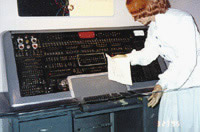Click on home button to open mainpage
UNIVersal Automatic Computer

| <picture creators>
hardware software |
The UNIVAC I was the world's first commercially available computer. 
General The first UNIVAC I was delivered on June 14, 1951. From 1951 to 1958
a total of 46 UNIVAC I computers were delivered, all of which have
since been phased out. In 1947, John Mauchly chose the name "UNIVAC" (Universal Automatic Computer) for his company's product. UNIVAC was designed by J. Presper Eckert and John Mauchly (designers of the ENIAC). Their company, the Eckert-Mauchly Computer Company, was purchased by Sperry-Rand.
The UNIVAC handled both numbers and alphabetic characters equally well. The UNIVAC I was unique in that it separated the complex problems of input and output from the actual computation facility. Mercury delay lines were used to store the computer's program. The program circulated within the lines in the form of acoustical pulses that could be read from the line and written into it. The first UNIVAC came on line for the U.S. Government's Census Bureau. The first commercial customer to purchase a UNIVAC was the Prudential Insurance Company. In 1952, the UNIVAC I successfully predicted the outcome of the 1952 presidential election, during a televised news broadcast. General Electric's Appliance Division created the first successful industrial payroll application for the UNIVAC I in 1954. In 1956, Westinghouse Electric Company installed a UNIVAC computer
in its East Pittsburgh plant. The UNIVAC was used to calculate company
payrolls, sales records, analysis of sales performance and other company
business. The UNIVAC could perform 90,000 transactions per month.
With Walter Cronkite anchoring the CBS 1952 Presidential Election Returns, on nationwide broadcast television, UNIVAC was used to predict who would win the election and become the next President of the United States.
The Computer Debuts on Television CBS fed the incoming Presidential election results into the UNIVAC which was using one of the first computer databases. Early in the evening, UNIVAC issused its computational prediction that Eisenhower would win. Conventional pundits overwhelmingly thought Adlai E. Stevenson would win and that the "computer made an error." So, CBS withheld its predictions from the air, but as the night went on, Walter Cronkite announced UNIVAC was right and Eisenhower had won. (1)
Specifications The machine was 25 feet by 50 feet in length, contained 5,600 tubes, 18,000 crystal diodes, and 300 relays. It utilized serial circuitry, 2.25 MHz bit rate, and had an internal storage capacity 1,000 words or 12,000 characters. It utilized a Mercury delay line, magnetic tape, and typewriter output. The UNIVAC was used for general purpose computing with large amounts of input and output. Power consumption was about 120 kva. Its reported processing speed was 0.525 milliseconds for arithmetic functions, 2.15 milliseconds for multiplication and 3.9 Milliseconds for division. The UNIVAC was also the first computer to come equipped with a magnetic tape unit and was the first computer to use buffer memory.
Chronology 1951 The first UNIVAC I was delivered on June 14, 1951. 1952 It made its star-studded public debut in November 1952 on the CBS television network. 1953 3 UNIVACs were installed and in operation 1954 Tthe first successful industrial payroll application by General Electric 8 UNIVACs were installed and in operation:
1956 Westinghouse Electric Company installed a UNIVAC to calculate company payrolls, sales records, analysis of sales performance and other company business.
1958 A total of 46 UNIVAC I computers were delivered
|
![]()
| Last Updated on 13 October, 2002 | For suggestions please mail the editors |
Footnotes & References
| 1 | the base of this text is taken from www.maxframe.com/history.htm |